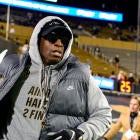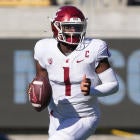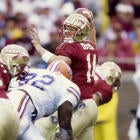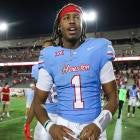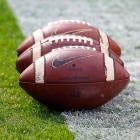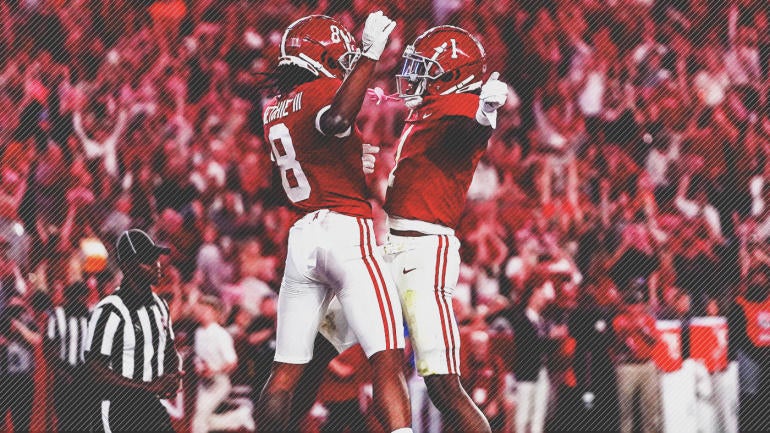
Dennis Simmons knew what was possible when he started recruiting a 5-foot-8, 155-pound junior college receiver out of the College of the Canyons in Santa Clarita, California.
"He lived in an apartment, six of these guys in a 1 ½-bedroom apartment," Simmons said of Marquise Brown. "By the time I met him in person, I thought, 'If this dude has that burning desire to be successful and focus on his craft, the rest of that stuff [will take care of itself].'"
At the time, Simmons was Oklahoma's outside receivers coach. Brown was walking to and from campus, 3 miles each way, to his job as an amusement ride operator at nearby Magic Mountain Six Flags. No car, no bus but plenty of will.
Never mind that any evaluation of his measurables deemed Brown smaller than small.
"That's why we have nutrition and strength and conditioning programs," Simmons concluded.
Simmons took a chance. Brown took it from there.
That burning desire turned into a career that included an All-America season at Oklahoma followed by 2,361 yards and 21 touchdowns over three seasons (and counting) in the NFL.
Serendipity has intervened on the road to success. Brown, now grown to 5-foot-9 and 180 pounds, plays with the same quarterback on the Baltimore Ravens he played against during youth football in his native Hollywood, Florida (Lamar Jackson).
This week of the NFL Draft, Brown is a symbol of the wide receiver position that has shaken off the coverage that has labeled it for decades. Not exactly complimentary in the past, receivers have never been as impactful as they are now.
In fact, a combination of factors have blended to make wideout the second-most important position on the field.
Call it a quantifiable assertion or an educated opinion. Offensive linemen, edge rushers and shut-down cornerbacks still earn larger contracts, but that's only one measure of importance.
"It's kind of like the tire cap on the tire," said Simmons, who recently followed Lincoln Riley from Oklahoma to USC. "You don't realize its value until you don't have it.'
It used to be: If you have a quarterback, you have a chance. That platitude has been refined.
Now, if you have a pitch-and-catch quarterback/receiver combo, you can dominate. All you have to do is look at the coach who made that assertion possible in recent years.
"With the advent of more and more passing in the NFL, more than 60% of the snaps now are passes, the receiver position becomes more important," Alabama coach Nick Saban told CBS Sports. "Explosive guys that have great catch radiuses are probably what everybody is looking for. In the old days, I think you probably looked for a more complete guy who was a good receiver but also a good blocker."
Some of the qualifications, labels and game plans have changed in just these last few years.
The Miami Dolphins are paying Tyreek Hill quarterback money. The Las Vegas Raiders are paying Davante Adams similarly. These days, Saban has cornered the market on all shapes and sizes to the point that slot receiver Slade Bolden -- he of 408 yards and three touchdowns for the Crimson Tide last season -- may get drafted this week.
Alabama has seen seven receivers drafted in the first round since 1996, the most of any program over the last quarter century. Five of those wideouts were taken in the first 15 picks, all since 2018. That's the most ever over a four-year period, according to Alabama research.
Explosive plays are all the rage. The average number of 20-yard completions per game has declined once since 2016. As usual, Saban has been ahead of the curve. Since 2017, the Tide have finished no lower than second among Power Five programs in completions of 20+ yards.
Saban doesn't have to say the obvious. You can't win big without difference-making pass catchers. From Julio Jones to Amari Cooper to Calvin Ridley to Jerry Jeudy to Jaylen Waddle to Henry Ruggs to Devonta Smith to Jameson Williams, Saban's had a steady rotation of home-run hitters.
Without one, well, witness last season. John Metchie III was knocked out with an ACL in the SEC Championship Game. Williamson suffered the same injury in the College Football Playoff National Championship. With no one to stretch the field, Alabama still led with 10 minutes left; however, Georgia scored the last 20 points of the game to clinch its first title in 41 years.
The next breakout receiver at Alabama is expected to be Louisville transfer Tyler Harrell. The standard to which he and others at the position will have to match: seven first-round draft choices, three All-America seasons and three Biletnikoff Awards since 2011.
The modern emphasis on explosive plays has made it imperative to get explosive players. So, why would you take a Kia Soul when you can fly first class on a supersonic airliner?
Welcome to the Age of the Wideout. If you haven't noticed, they are best, quickest, way to the end zone.
"I'll go out of [recruiting] profile on somebody who is that elite in terms of speed," LSU coach Brian Kelly told CBS Sports. "If he's 5-foot-8 and but running 4.3 [seconds in the 40-yard dash], I'll go out of profile for guys like that. He'll change the complexion of the game. He's a touchdown if you miss a block."
For the seventh time in the last nine years, there figures to be more receivers taken in the draft than there are NFL teams (32). A new record was set in 2021 with FBS teams averaging 7.54 yards per pass attempt. The top six most productive seasons nationally in that category have come since 2015.
It is a perfect time to be a receiver and have the words "game-changing" attached to you. Hill got $120 million from the Dolphins. Adams got $140 after signing with the Raiders. It's hard to envision the Cincinnati Bengals making the Super Bowl without rookie Ja'Marr Chase.
Pittsburgh won the ACC with Biletnikoff Award winner Jordan Addison catching 1,400 yards worth of passes from Kenny Pickett. USC's Drake London -- one of the top receivers in the 2022 NFL Draft -- needed only eight games to catch 88 passes before being injured.
"I hate that I didn't have the opportunity to work hand-in-hand with the kid," said Simmons, who arrived in December 2021, the same month London declared early for the draft.
To plant his flag on the West Coast, Riley had to bring Simmons with him from Oklahoma. Simmons, a former BYU linebacker, might be the best receivers coach in the country. On his watch, OU developed Brown, unanimous All-American Dede Westbrook and All-American CeeDee Lamb.
Now comes the hard part: plugging in that receiving culture at a program that has pumped out pro receivers in bulk. USC is No. 1 all-time in the draft with 50 wideouts selected. Simmons' current peers work at other programs in the top 10: Brian Hartline is at Ohio State (second all-time with 46), Holman Wiggins -- one of the most respected names in the game -- is at Alabama (10th all-time with 25).
It should be no surprise that the nine college teams with the most receivers drafted in history have won half the national championships in the BCS era (12 of 24). (This includes a split title between LSU and USC in 2003.)
"You play quarterback, everything that happens, happens in front of you," Simmons said. "You play receiver, you're running through what is changing. You have to recognize it on the move. That's something that gets lost. The receiver has to see his picture as he is moving through it."
At Oklahoma and now USC, the reminder to run through a catch comes on every rep.
"We're expecting you to turn a routine play into an explosive play," Simmons said. "We really want these guys to strain after the catch. If you haven't mastered the art of catching the ball, you wouldn't be at a place like USC.
"The average ones catch it; the elite ones maximize the yards after they [catch] it."
Alabama's Williams just might be the most is the most important player in the draft. Not because of the usual reasons like his immense talent. Before he blew out his left knee in the title game, Williams might have been the best receiver and top player from his position selected in the NFL Draft.
In fact, that might still happen. However, that ACL injury must be giving teams pause. How much will a general manager and/or coach be willing to gamble on that knee? A lot, it turns out. Initial projections were that Williams would drop to the bottom of the first round, but that has changed as Williams' rehabilitation has progressed faster than expected.
Williams' agent said his client would be running by the draft and even tweeted a video. Teams may be willing to overlook that injury because of Williams' value at his position. Research shows, in the 24 months following ACL reconstruction, athletes are at much greater risk to suffer a recurrence of the injury.
Best Receiver in the draft . Watch for yourself @BuckyBrooks @MoveTheSticks @LRiddickESPN @RapSheet @AdamSchefter pic.twitter.com/CzhFRl6waF
— Rocky Arceneaux (@Alliance_Sports) April 25, 2022
Williams could start the season on the physically unable to perform (PUP) list, but interested NFL teams are willing to wait. He would have to fall significantly from his current top 10-15 projection for the injury to have a lasting impact on his career earning power.
"The reason all these receivers are so good now coming out of college is because high schools are doing it. Everything is wide open now," said Ryan Wilson, CBS Sports' NFL Draft expert. "The Steelers thing is, 'We don't have draft a wide receiver in the first round. We can get these guys second, third, fourth round. We can turn them into players.'"
The LSU staff was glancing at its recruiting board recently. The usual influencer positions stood out.
"Left tackle, quarterback, cornerback, guys that impact the game," Kelly recalled. "We said, 'There are very few guys who can impact the game at other positions unless they have elite speed.'"
Maybe only that receiver position, given recent events. There would arguably be no Alabama dynasty without Saban's difference-making receivers. Know your alphabet. The X and Y are the key to offensive ABCs. There's a reason why five-receiver sets employ as many pass catchers as offensive linemen.
Kelly was speaking specifically about the talk of the offseason: The Kansas City Chiefs' trade of Hill to the Dolphins was only slightly more shocking than what his new employers paid him. The four-year, $120 million contract not only rocked the NFL but filtered down to colleges where the emphasis on wideouts has been obvious for a while now.
Those positions Kelly mentioned? All make more money than receivers. However, wideouts have never been more important to the game. The combination of the position, its utilization and the way the game is being played make it so.
"In my opinion, honestly, I think it's swung too far in that direction," said Matt Manocherian, a former NFL scout who is now a researcher for analytics firm Sports Info Solutions. "Receivers getting paid the way they are getting paid now is an overcorrection. But if you just go on what's happening, I think they're right there with the best edge rushers and the best corners [in terms of value]."
The 37 receivers taken in the 2020 NFL Draft tied for the most since the draft went from 12 rounds to the current structure of seven rounds in 1994. The six first-round wideouts taken that year tied for the second-most since 1994. The combined 11 first-round receivers the last two years -- one out of every 6.5 players drafted -- are the most since 2004-05.
"It's a touchdown maker," Missouri coach Eli Drinkwitz said of the position. "It's somebody who has the ability to score touchdowns. Your quarterback has the ability to create and distribute the football. Now, with the way college football is played and football in general is played, [it's] about getting your playmaker the ball in space."
"Really, everybody has redesigned the position," Drinkwitz added. "Look at [San Francisco 49ers WR] Deebo Samuel and how he is getting the ball through handoffs. It's about getting your dynamic playmakers the ball. How you do it is up to the coach."
LSU's Jontre Kirklin was smiling during the Tigers pro day earlier this month. The veteran had three receptions in his first three seasons; he ended with 20 across his five campaigns at LSU. Kirklin ended his college career as an emergency quarterback in the Texas Bowl against Kansas State when LSU ran out of healthy bodies.
But considering the soaring worth of receivers, his pro prospects just got better. Kirklin's vertical jump was NBA-worthy at 43 inches, 4.5 inches higher than any of his teammates. His broad jump of 11'5" also led the team. Only star cornerback Derek Stingley Jr. (4.37 seconds) ran a faster 40-yard dash than Kirklin (4.52).
"I am the most versatile player in the draft because of my football IQ," proclaimed Kirklin, an expected undrafted free-agent prospect.
Why not? Kirklin thinks he can catch at the next level.
It will only take one team to see the value.













